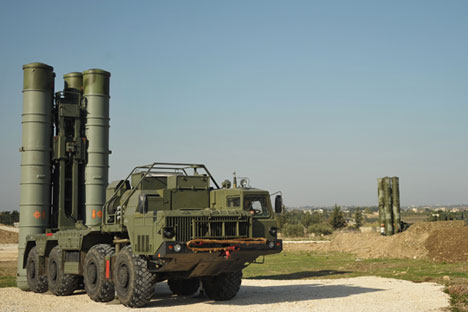
An S-400 air defence missile system is deployed for a combat duty at the Hmeymim airbase to provide security of the Russian air group's flights in Syria.
RIA Novosti/Dmitry VinogradovDeployment of the S-400 anti-aircraft missile system at the Russian airbase in Khmeimim, Syria, is the Russian government’s response to the downing of the Su-24 Russian bomber by a Turkish F-16 destroyer in Syrian airspace. In the course of the rescue of the Su-24's navigator, a Russian marine also died and the Russian Air Force lost a multi-purpose Mi-8 helicopter, on November 24.
On November 25 Russian Defence Minister Sergei Shoigu said Russia's airbase in Syria would strengthen its defences and President Vladimir Putin ordered the S-400 anti-aircraft missile system be deployed in the region to better protect the Russian aircraft. Now Russian anti-aircraft weapons will be defending a distance of 20 to 400 kilometres and a height of 3 to 30 kilometres.
1. What is the S-400?
The ‘Triumph’ S-400 is a key part of Russia's anti-aircraft defence. This is a new-generation medium and long-range anti-aircraft missile system. Currently, it is Russia's main anti-aircraft defence in Syria. The entire system can be set up for use in 5 to 10 minutes.
Source: TV Channel "Zvezda"
2. What can the Triumph shoot down and at what distance?
The Triumph is capable of wiping out enemy planes at a great distance. At a distance of 400 kilometres, the system can strike planes, and at a distance of 60 kms, its can hit tactical ballistic targets flying at a speed of 4.8 kms per second, as well as winged missiles and ballistic missiles.
Considering the S-400's radius of activity, practically all of the Syrian sky will be under control, as will a part of Turkey, Cyprus, the eastern Mediterranean and Israel.
3. From where was the S-400 brought to Syria?
The S-400 was taken to Syria from Moscow's suburbs, where it was on duty "covering" the capital. Now one of the systems will be serving in Syria.
4. How did Russia protect its base in Syria before deploying the S-400?
Before the S-400 the main "umbrella" protecting the Russian base from an enemy airstrike was the self-propelled ‘Buk’ anti-aircraft missile system, one of the most effective medium-range anti-aircraft defense systems in the world today. It is capable of reaching air targets at a height of 25,000 meters. The Buk can also strike ballistic missiles, as well as strategic and tactical aviation. The maximum radius of its activity is 3 to 40 kilometers.
5. How does Russia protect its base at sea?
After the incident with the downed Su-24 on November 25 the ‘Moskva’ guided missile cruiser, which is equipped with the vertically launched Fort anti-aircraft defense system (the sea version of the S-300), approached Syrian shores in the vicinity of Latakia. It is now on military duty protecting Russian airbases with its medium-range anti-aircraft defense system.
6. What exactly does the sea S-300 do?
It protects coastal borders and ship connections from airplanes carrying anti-ship missiles, including guided missiles that are capable of manoeuvering at low heights. The Fort's maximum striking distance and height are 150 and 30 kilometers, respectively.
Source: TV Channel "Zvezda"
7. What other defence systems does Russia use in Syria?
The ‘Pantsir S1’, an essential component of Russia's anti-aircraft defense system, continues looking after the base in Khmeimim. Its mission is to protect the long distance S-400s from potential airstrikes with its guided missiles and cannon shots. The Pantsirs are also responsible for protecting small objects on the base, such as the soldiers' relaxation areas.
8. What has Turkey done after the deployment of the S-400?
Turkey has decided to cancel its military flights in Syria, where its pilots were part of the international anti-IS coalition.
All rights reserved by Rossiyskaya Gazeta.
Subscribe
to our newsletter!
Get the week's best stories straight to your inbox